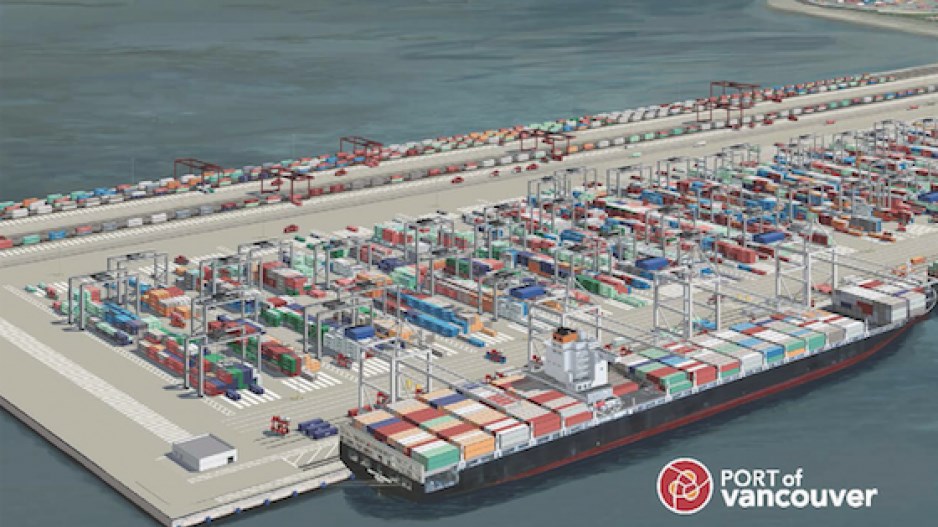Automation has joined environment
It’s also central to contract negotiations that temporarily ran off the rails last week between
The Vancouver Fraser Port Authority’s (VFPA) proposal to sink $2.8 billion into a new container cargo facility at Roberts Bank in Delta is also raising concerns over who would operate the terminal if the project is approved and what that would mean for the future of high-paying
In his May 16 presentation to the CEAA panel Tom Doran, president of the 3,000-member ILWU Local 502, said Terminal 2’s net economic impact had not been adequately assessed “particularly as it relates to the impact of automation on our industry and our communities.”
He claimed that fully automated and digitized marine terminal operations elsewhere in the world have reduced port workforces by as much as 70% to 80%.
Doran added that the container cargo sector generates roughly 70% of
“I would like to underscore that automation is a choice, and it’s not a foregone conclusion in economic development or decisions around productivity, sustainability or the environment.”
The percentage of Terminal 2 operations that will be automated depends on its final design and who the VFPA chooses as the
But Cliff Stewart, the VFPA’s vice-president of infrastructure, told the review panel that the terminal’s main yard would likely be semi-automated because, as he noted, there are some port and cargo movement jobs that robots and automation do better and some that humans do better.
However, Terminal 2, if approved, would not be operating for at least nine years. Container cargo technology will likely have changed radically by then.
The VFPA currently estimates that Terminal 2 would create 1,000 new container terminal jobs.
Doran is not alone in questioning the port automation equation.
As noted in “Tech’s Next Wave: Automated Cargo Movement” (Business in Vancouver issue 1540; May 7-13), McKinsey & Co.’s The Future of Automated Ports report found that, while operating expenses at automated
That lowers return on investment in a sector where upgrading or overhauling infrastructure is extremely expensive.
The port business is also under stress. U
Ongoing trade wars and rising global protectionism will not help that.
Lars Jensen, the CEO of Copenhagen-based SeaIntelligence Consulting, also pointed out to Business in Vancouver that there are very few fully automated container terminals in the world. That is unlikely to change significantly any time soon.
High costs and relatively low overall productivity and efficiency weigh against
After observing a fully automated terminal in action, Jensen was lukewarm on its overall performance.
“At least where I saw it automated last year,” he said, “there was not a strong case to be made that a fully automated terminal was necessarily more efficient than a manual terminal in terms of how many containers you can handle per hour, per square foot or however you want to measure it.”
Again, that comes down to robots being no more efficient than experienced humans when operating machinery like the huge gantry cranes that load and unload containers from ships.
But Jensen added that a combination of automation and manual
That
Terminal 2 would add about 2.4 million 20-foot-equivalent units (TEUs) to the Port of Vancouver’s annual container handling capacity. The port handled 3.4 million TEUs in 2018.
The VFPA has said that without Terminal 2’s additional container handling capacity and more-
More business could also be lost to ports along the Gulf of Mexico and Eastern Seaboard as larger ships move with greater frequency through the expanded Panama Canal.
Mexican ports are also taking a bigger share of transpacific container cargo.
Consolidation and alliances in the global shipping sector combined with major carriers investing in larger container ships will reduce frequency of port calls and choice of shipping lines.
That is not good for container terminals unwilling or unable to invest in technology and infrastructure upgrades.
Doran also raised Terminal 2 management concerns.
The VFPA does not want either of the two companies that now operate Port of Vancouver’s container terminals to manage Terminal 2.
So GCT Global Container Terminals Inc., which manages GCT Deltaport and Vanterm, and DP World, which runs Centerm in Vancouver and Fairview in Prince Rupert, need not apply.
GCT has proposed an expansion of its Deltaport terminal, which could delay the need for Terminal 2. But because the VFPA has refused to process the company’s preliminary project
Earlier this year, DP World, which operates 78 container terminals, bought Fraser Surrey Docks.
Progress on securing a Terminal 2 operator is unknown.
The Port of Vancouver released a short list of five in November 2015, but the VFPA has made no announcement
Doran told the hearing that port workers and British Columbians “have a right to know who will run this terminal.”
“Large corporations controlled offshore who are only accountable to their shareholders should not dictate how a development that Canadians pay for should operate, especially if their decision comes with a negative economic impact on our communities,” he said. “We also have the right to know what the mode of operation will be, and if it will be a job killer or not.” •




